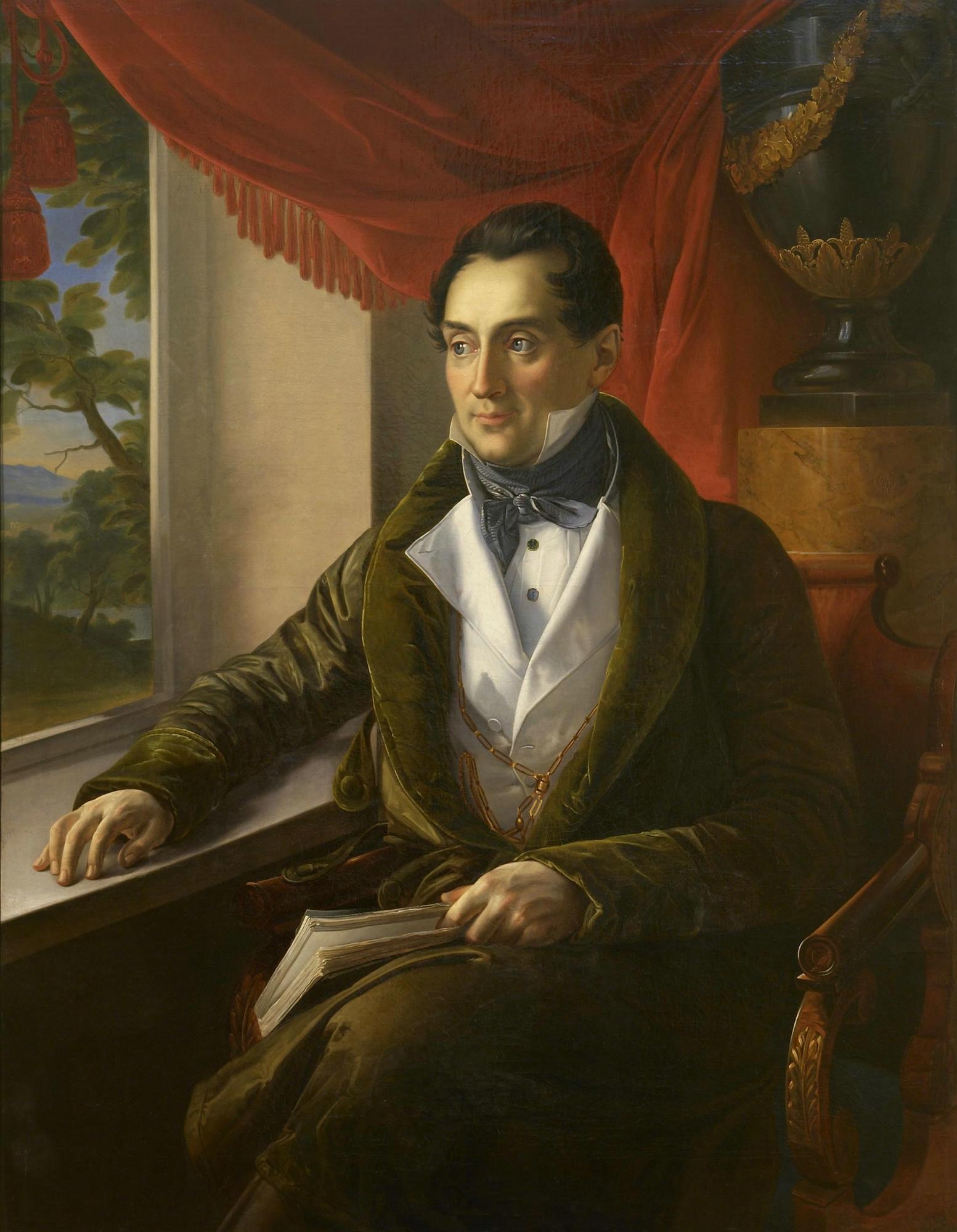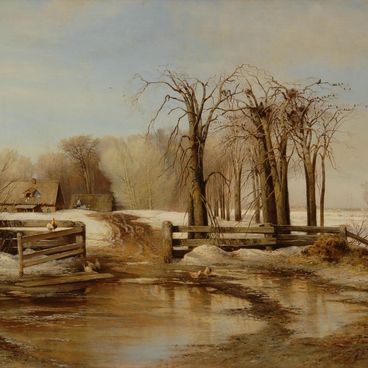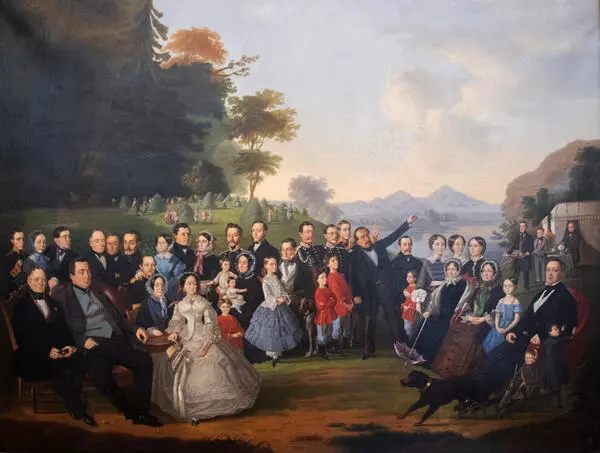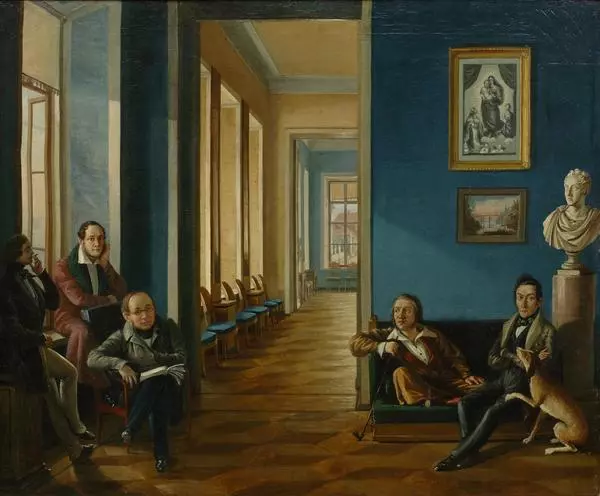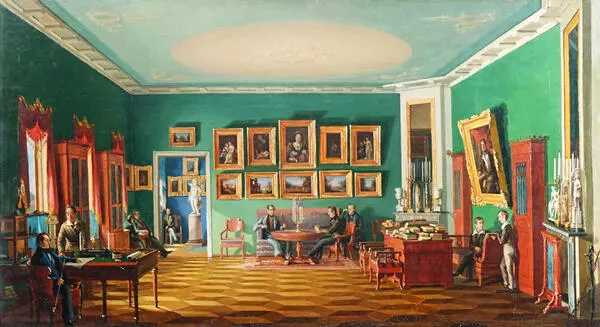This painting was included in the collection of the museum among the Suvorovs - Zubovs family portraits. This traditional group portrait, typical of 19th-century manor painting, depicts the study of Count Platon Zubov as well as the owner himself, who is sitting on the couch surrounded by his friends.
Platon Zubov was the second of the three sons of Natalia Zubova, the daughter of the great military commander Alexandre Suvorov. Zubov’s life journey, as well as the fate of most Russian noblemen’s children, was predetermined almost from childhood. He graduated with distinction from the Corps of Pages, the most prestigious military educational institution in the country: Platon Zubov’s name was entered on the marble board [featuring cum-laude graduates]. He joined the Chevalier Guards Regiment, but resigned 11 years later to start working as a special assignments official with at the Ministry of Finance.
Platon Zubov was fond of art through his entire life. Significant wealth allowed him to amass an impressive collection of works of art - paintings, sculptures, miniatures and many others. This collection was kept in the comfortable house of Countess Zubova on Povarskaya Street in Moscow with one of its rooms depicted in the picture.
The author of the canvas, Nikolai Podklyuchnikov, was the serf of the Earls of Sheremetevs. He came from a family of hereditary icon painters, artists and restorers. Podklyuchnikov got his first painting lessons from his father and, at the age of 20, he began studies in the Art class that got started in Moscow. To get to the classes, the artist had to walk every day from the village of Ostankino, where he was born and grew up, to the city center - and back. In 1839, Podklyuchnikov was set free; he received a certificate of graduation and moved to Moscow for good. At the same time, he presented four works to the Academy of Arts exhibition, with the Perspective of Count Zubov’s Study among them.
However, the specialists have failed to definitively determine whether this particular version of the picture is now in our exhibition, or one of its later versions. Podklyuchnikov repeatedly painted signature copies of his own works, and it is a known fact that similar paintings with the interiors of the Count’s office were stored at the Zubov sisters’ places: Olga (married name Talyzina) and Lyubov (married name Leontiev).
Platon Zubov was the second of the three sons of Natalia Zubova, the daughter of the great military commander Alexandre Suvorov. Zubov’s life journey, as well as the fate of most Russian noblemen’s children, was predetermined almost from childhood. He graduated with distinction from the Corps of Pages, the most prestigious military educational institution in the country: Platon Zubov’s name was entered on the marble board [featuring cum-laude graduates]. He joined the Chevalier Guards Regiment, but resigned 11 years later to start working as a special assignments official with at the Ministry of Finance.
Platon Zubov was fond of art through his entire life. Significant wealth allowed him to amass an impressive collection of works of art - paintings, sculptures, miniatures and many others. This collection was kept in the comfortable house of Countess Zubova on Povarskaya Street in Moscow with one of its rooms depicted in the picture.
The author of the canvas, Nikolai Podklyuchnikov, was the serf of the Earls of Sheremetevs. He came from a family of hereditary icon painters, artists and restorers. Podklyuchnikov got his first painting lessons from his father and, at the age of 20, he began studies in the Art class that got started in Moscow. To get to the classes, the artist had to walk every day from the village of Ostankino, where he was born and grew up, to the city center - and back. In 1839, Podklyuchnikov was set free; he received a certificate of graduation and moved to Moscow for good. At the same time, he presented four works to the Academy of Arts exhibition, with the Perspective of Count Zubov’s Study among them.
However, the specialists have failed to definitively determine whether this particular version of the picture is now in our exhibition, or one of its later versions. Podklyuchnikov repeatedly painted signature copies of his own works, and it is a known fact that similar paintings with the interiors of the Count’s office were stored at the Zubov sisters’ places: Olga (married name Talyzina) and Lyubov (married name Leontiev).
